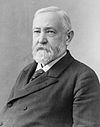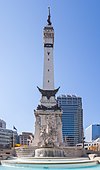
Charles Henry Niehaus was an American sculptor.
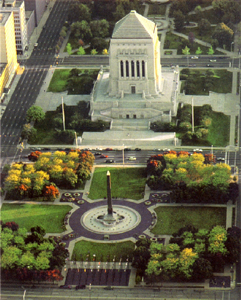
The Indiana World War Memorial Plaza is an urban feature and war memorial located in downtown Indianapolis, Indiana, United States, originally built to honor the veterans of World War I. It was conceived in 1919 as a location for the national headquarters of the American Legion and a memorial to the state's and nation's veterans.

The Lincoln Monument of Wabash, Indiana or The Great Emancipator is a public sculpture by Charles Keck, a sculptor who was born in New York City. The cast bronze sculpture was commissioned by Wabash-native Alexander New and donated to the city of Wabash, Indiana, in 1932. It has remained on view at the northeast corner of the Wabash County Courthouse lawn ever since.

Piatt Park is the oldest park in Cincinnati, Ohio. The urban park stretches two blocks between Elm Street and Vine Street on Garfield Place/8th Street. The park is owned and maintained by the Cincinnati Park Board.

The IUPUI Public Art Collection, located in Indianapolis, Indiana, United States, consists of more than 30 works of sculpture located outdoors on the campus of Indiana University–Purdue University Indianapolis. IUPUI is a public shared campus of Indiana University and Purdue University that was created in 1969. More than 30,000 students attend IUPUI today and view the sculptures as they walk, bicycle, and drive around the campus.

The Thomas A. Hendricks Monument is a public artwork by American artist Richard Henry Park and is located on the southeast corner of the Indiana Statehouse grounds in Indianapolis, Indiana. The monument is a tribute to Thomas A. Hendricks, the 21st Vice President of the United States. Hendricks was a former U.S. Representative and U.S. Senator from Indiana. He was the 16th Governor of Indiana and led the campaign to build the Indiana Statehouse.
E Pluribus Unum is a public artwork proposed by American artist Fred Wilson to be located along the Indianapolis Cultural Trail at the northeast corner of Delaware and Washington streets, near the City-County Building in downtown Indianapolis, Indiana, United States.

Stephen Neal is a public artwork by Indiana artist Clara Barth Leonard. It is located in the Indiana Statehouse, which is in Indianapolis, Indiana, United States. The subject of the work is Stephen Neal, a member of the Indiana State Legislature and a Judge of the Boone County Circuit Court during the mid-to-late-19th century, as well as being the author of the original draft of the Fourteenth Amendment to the United States Constitution. The bronze bust is located on the second floor of the Indiana Statehouse in a waist-high limestone niche, and faces west towards North Senate Avenue.
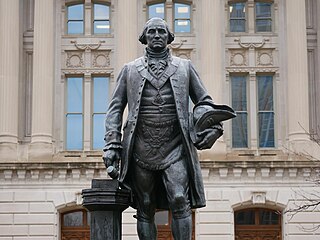
George Washington is a public artwork by American sculptor Donald De Lue, located on the grounds of the Indiana Statehouse, in Indianapolis, Indiana, United States. The bronze statue of George Washington that occupies the Indiana Statehouse south lawn is one of several copies of a 1959 original wax cast at the Modern Art Foundry in Long Island, New York.

Stumbling Man is an outdoor sculpture by American artist David K. Rubins (1902–1985) located on the grounds of the Indianapolis Museum of Art (IMA), which is near downtown Indianapolis, Indiana. The sculpture is cast bronze and is in the shape of a man crouched upon the ground.
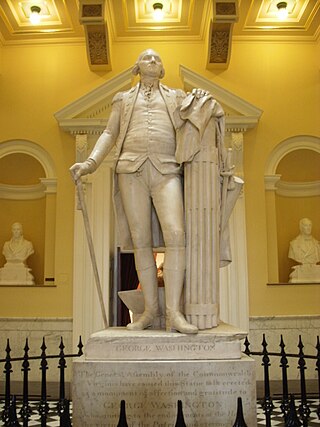
George Washington is a statue by the French sculptor Jean-Antoine Houdon from the late 18th century. Based on a life mask and other measurements of George Washington taken by Houdon, it is considered one of the most accurate depictions of the subject. The original sculpture is located in the rotunda of the Virginia State Capitol in Richmond, Virginia, and it has been copied extensively, with one copy standing in the United States Capitol Rotunda.

American Revolution Statuary is a group of fourteen statues in Washington, D.C., which honor men whose actions assisted the Thirteen Colonies in their fight against the Kingdom of Great Britain in the American Revolutionary War. They are spread throughout the city, except for the four statues in Lafayette Square, across from the White House, that honor some of the foreign heroes from the war. Some of the statues are located in prominent places, while others are in small parks or stand alone in front of buildings. All of the statues are owned and maintained by the National Park Service, an agency of the United States Department of the Interior. The statuary was collectively listed on the National Register of Historic Places (NRHP) in 1978 and the District of Columbia Inventory of Historic Sites the following year. In addition, most are also contributing properties to historic districts listed on the NRHP.
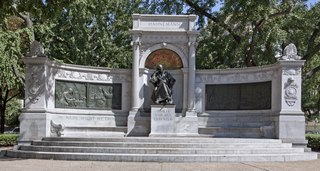
The Samuel Hahnemann Monument, also known as Dr. Samuel Hahnemann, is a public artwork dedicated to Samuel Hahnemann, the founder of homeopathy. It is located on the east side of Scott Circle, a traffic circle in the northwest quadrant of Washington, D.C. The Classical Revival monument consists of an exedra designed by architect Julius Harder and a statue sculpted by Charles Henry Niehaus, whose works include the John Paul Jones Memorial in Washington, D.C., and several statues in the National Statuary Hall Collection. The monument is significant because Hahnemann is the first foreigner not associated with the American Revolution to be honored with a sculpture in Washington, D.C.
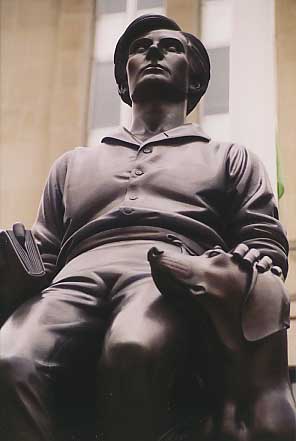
Abraham Lincoln, The Hoosier Youth is a heroic bronze sculpture by American artist Paul Manship and was commissioned in 1928 by the Lincoln National Life Insurance Company for its headquarters in Fort Wayne, Indiana. The statue is 12.5 feet (3.8 m) tall and sits atop a pedestal designed by architect Benjamin Wistar Morris and a granite base. The sculpture depicts a youthful Abraham Lincoln during the time he lived in Indiana. The Lincoln figure wears a handmade shirt, buckskin trousers, and boots. He is seated on a tree stump and holds a book. An ax leans against his leg and a dog is seated beside him. Manship also sculpted four bronze allegorical bas reliefs, one for each side of the pedestal, to represent traits associated with Lincoln: Charity, Fortitude, Justice and Patriotism. The statue was dedicated on 16 September 1932.

Thomas Jefferson is a 1911 bronze statue of a seated Thomas Jefferson created by Karl Bitter for the Cuyahoga County Courthouse in Cleveland, Ohio, United States.

Henry Clay is a 1929 bronze sculpture by Charles Henry Niehaus depicting the lawyer and politician Henry Clay, installed in the United States Capitol in Washington D.C. as part of the National Statuary Hall Collection. It is one of two statues donated by the state of Kentucky. The statue was accepted into the collection by Virgil Chapman on March 3, 1929.

Orpheus with the Awkward Foot is a monumental statue located at Fort McHenry in Baltimore, Maryland, United States. The monument, designed by sculptor Charles Henry Niehaus, was commissioned by the United States Commission of Fine Arts to commemorate the 100th anniversary of the writing of "The Star-Spangled Banner", written by Francis Scott Key during the Battle of Baltimore in 1814. The statue was dedicated in 1922, with U.S. President Warren G. Harding in attendance.

A statue of Abraham Lincoln by Henry Hering, sometimes called Abraham Lincoln or Seated Lincoln, is installed in Indianapolis, Indiana, United States, in University Park.



















